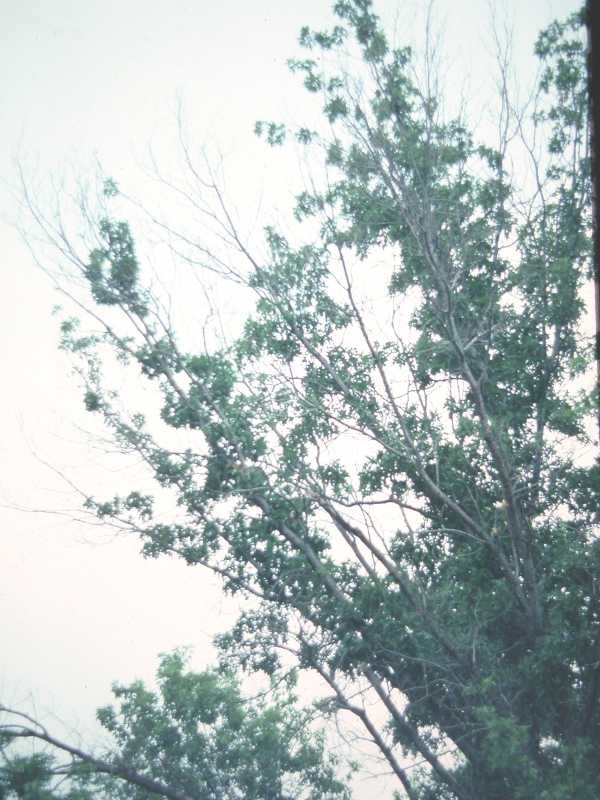Ferida Wolff's Backyard: Blogcation and Poor Oak Trees
Blogcation

I always loved summer as a kid. Besides it bringing my birthday, school was out and my friends and I spent most of the long, hot days outside. I also spent lots of time in the library catching up on books by my favorite authors. Sometimes my family would have a picnic with the cousins or we'd spend a day at the beach. It was welcome time away from our usual activities. So when summer came upon us this year I decided to take a needed blogcation for a few weeks to regenerate myself.
Now it's time to return to my backyard. My blogcation helped me look at things through refreshed eyes. And I see that the yard needs tending. Things have grown abundantly over the years. The trees we planted for shade have done their job very well. The yard looks wooded and natural but we see that the bulbs we had planted no long bear flowers because of the shade generated by the trees. The privet hedges are long and lanky, reaching up through the tree branches to find the sun. The lovely Rose-of-Sharon (also known as Hibiscus syriacus) bush spread to the other side of the yard and the seedlings seem to want to take over. Yes, tending is in order.
At least I have the choice of gardening or resting; not everything in nature has that option. The bees have been busy gathering nectar and pollen from the Hibiscus and Echinacea flowers. They sing their way around the purple Salvia and Butterfly Bushes. Their visitations help distribute the pollen that fertilizes the plants. I hear them buzzing in the vegetable garden and I am grateful for their help. They make the juicy tomatoes we so love possible. In fact, a good portion of everyone’s diet is facilitated by honeybee pollination.
Which brings up the problem of Colony Collapse Disorder (CCD). Our honeybees are in trouble. More colonies than ever have been failing. Several dead hives have been found. Sometimes a queen bee and immature bees are present but no adult bees to do the hive’s work. The Agricultural Research Service (ARS), USDA's internal research agency, is trying to find out what causes CCD. Is it due to pesticides? Is it merely cyclical? Does it reflect poor management?
It makes a case for all of us being dependent upon each other. Bees are important to our survival — and we are necessary to theirs. As I enjoy the fruits — and vegetables — of their labor, I hope that we find a way to guarantee their continued presence. Come autumn, the old guard will be over and the new queens will hibernate until the next spring approaches. I understand about down time, even in Nature, but let’s not make CCD a permanent state for the bees.
Become familiar with the life of the honeybee:
http://bumblebeeconservation.org/about-bees/lifecycle/
Understand the problems bees currently face:
Poor Oak Trees
I’m feeling kind of sad about my oak tree. It has been gracing our house at the curb for almost forty years, supplying acorns for the squirrels, a fine nesting place for the birds, shade on hot summer days, and lovely, graceful leaves for atmosphere. This summer it is having troubles. Some of its branches are bare and on those that still have greenery, the leaves are not as abundant as they had been in the past. I wonder if the poor tree will last through the winter.
We go for walks every night after dinner when the heat of the day starts to mellow and we are noticing that many oak trees in our development are showing the same kinds of symptoms. There are woodpeckers in the area and sapsuckers are known to "bleed" a tree to get the sap, which harms the tree. Is there an oak tree disease ravaging these beauties? But then, their environment may be the problem. They were planted in a confined space. Their roots are reaching out desperately for somewhere to grow, raising concrete slabs, sending roots out along the curbside seeking nourishment. Or is it Oak Wilt? Photos from various botanical gardens seem to suggest that it is. My heart aches for the trees I see with receding growth as I learned that it is usually fatal.
Dieback on oak (Quercus) caused by oak wilt; Missouri Botanical Garden photo
There is a time for everything to flourish, I guess, and then to draw away. It's hard to accept that sometimes that withdrawal is hastened; the oaks should last longer than this. Nature is a continuum of growth and loss. We can delay the process now and then but there is a time for it all. Perhaps our appreciation of what we have is the best way to understand the cycle — and to live life fully.
About Oak Wilt:
Missouri Botanical Garden and Oak Wilt
©2015 Ferida Wolff for SeniorWomen.com
More Articles
- Ferida Wolff's Backyard: Spring is Coming
- Ferida Wolff Writes: Our Senses
- The Autobiography of a Garden at The Huntington, a Joy for Viewers and Gardeners
- Ferida Wolff's Backyard: Caring for Our Climate and Our Earth; Inside and Outside; NASA's New Spacesuit for Artemis Generation Astronauts
- Ferida Wolff's Backyard: Swans and Duck Together; Life Ripens and Robin's Beautiful Eggs
- Ferida Wolff's Backyard: Nature's Progression and A Robin's Beautiful Eggs
- Ferida Wolff's Backyard Garden: My Surprising Garden and Basil is a Great Herb
- Ferida Wolff's Backyard: Geese and Growth
- The Creativity Sweeps: Everything Those Teachers Did, They Did With Flair; They Knew No Bounds
- $30.2 Billion: Diverse Medical and Health Care Systems, Herbal Supplements, Meditation, Chiropractic, and Yoga






